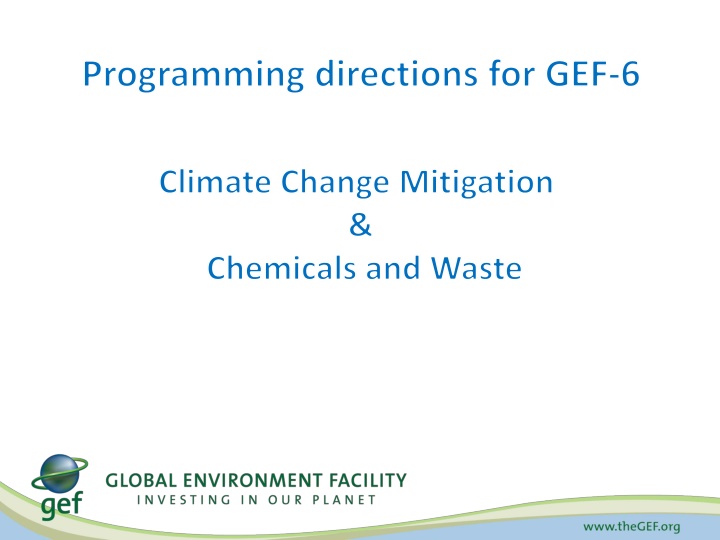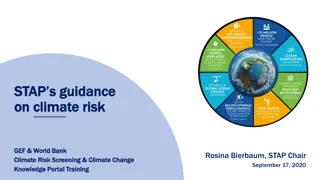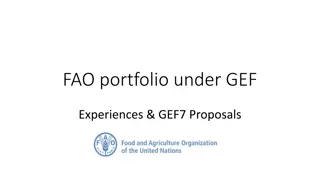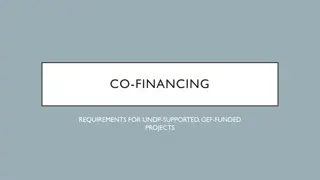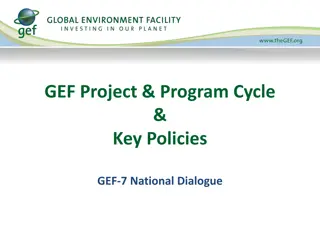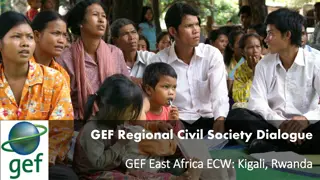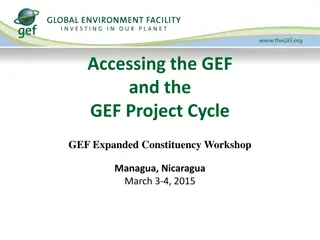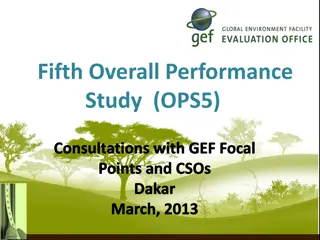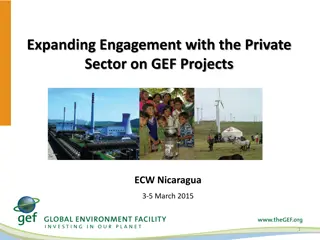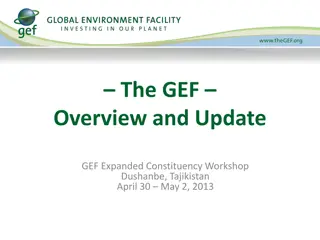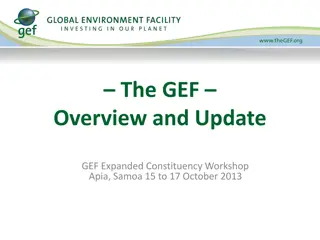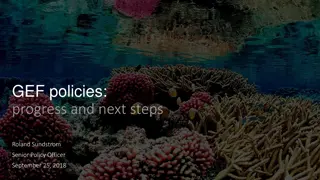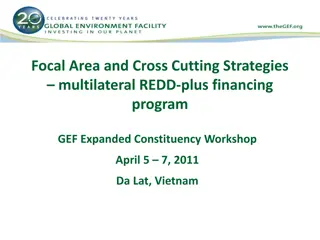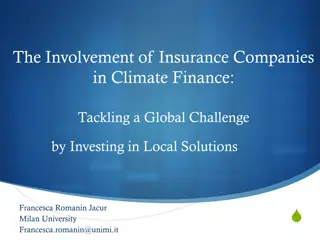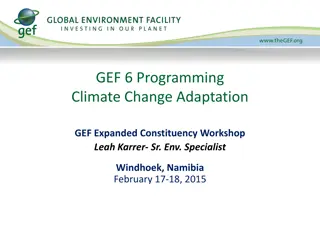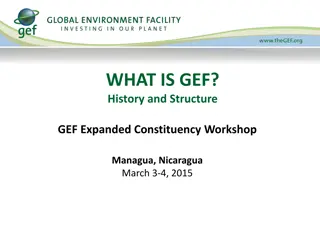Programming Directions for GEF-6 Climate Change Mitigation
GEF-6 focuses on climate change mitigation, chemicals, and waste management through innovative strategies and financial mechanisms supporting global conventions. The proposed programs aim to promote low-carbon technologies, innovation, and systemic impacts to achieve transformative change towards sustainable development.
Download Presentation

Please find below an Image/Link to download the presentation.
The content on the website is provided AS IS for your information and personal use only. It may not be sold, licensed, or shared on other websites without obtaining consent from the author.If you encounter any issues during the download, it is possible that the publisher has removed the file from their server.
You are allowed to download the files provided on this website for personal or commercial use, subject to the condition that they are used lawfully. All files are the property of their respective owners.
The content on the website is provided AS IS for your information and personal use only. It may not be sold, licensed, or shared on other websites without obtaining consent from the author.
E N D
Presentation Transcript
Programming directions for GEF-6 Climate Change Mitigation & Chemicals and Waste
GEF and the Conventions The Global Environment Facility: Is the financial mechanism for the Stockholm Convention on Persistent Organic Pollutants the financial mechanism for the Minamata Convention on Mercury Supports the implementation of the Montreal Protocol in countries with economies in transition It is an operating entity of the financial mechanism of the UNFCCC
GEFs Unique Value for Climate Financing 1. Facilitating innovation & technology transfer Assisting recipient countries prepare for new climate regime under UNFCCC that seeks commitments to emission reduction at universal level 2. Catalyzing systemic impacts through synergistic multi-focal initiatives 3. Building on Convention obligations for reporting & assessments towards mainstreaming
Proposed GEF-6 CCM Strategy Program 1: Promote timely development, demonstration and financing of low carbon technologies and mitigation options Program 2: Develop and demonstrate innovative policy packages and market initiatives 1. Promote innovation & technology transfer Goal: To support developing countries and economies in transition in achieving transformational change towards development with low carbon emissions Program 3: Promote integrated low-carbon systems Program 4: Promote conservation and enhancement of carbon stocks in forest and other land use, & support climate smart agriculture 2. Demonstrate systemic impacts of mitigation options 3. Foster enabling conditions to mainstream mitigation concerns Program 5: Integrate findings of Convention obligations and enabling activities into national planning processes & mitigation targets
Objective 1 - Promote Innovation and Technology Transfer Program 1: Promote the timely development, demonstration, and financing of low-carbon technologies and mitigation options Focus on technologies which are not yet commercially available Greater emphasis on the early stages of the innovation chain, where risk mitigation is more important Supports the creation of an enabling environment in terms of policies, mechanisms and regulations, as well as legal frameworks that facilitate the implementation of these technologies Once tested, we will seek and increase in scale
Objective 1 - Promote Innovation and Technology Transfer Program 2: Develop and demonstrate innovative policy packages and market initiatives to foster a new range of mitigation actions Particularly supports countries that seek to mitigate the generation of carbon emissions in their policy frameworks that are consistent with the results of their national communications, BUR and other reports. Offer countries the possibility to test innovative incentives for of emission reductions (direct payment, carbon tax, use of non-grant instruments, private sector investment). Support financial risk assessment in carbon markets Incentives programs or sectors that have been identified by a country, for example, limiting GHG emissions
Objective 2 Demonstrate systemic impacts of mitigation options Program 1: Promote integrated low-carbon urban systems Support the GEF-6 Sustainable Cities signature initiative. Focus on urban projects with significant climate change mitigation potential, to help cities shift towards low-carbon urban development Promote sustainable production and consumption practices to de- couple urban growth and resource use (reduce use of POPs, methane emissions, mercury, lead, and e-waste) Support sustainable transport infrastructure and systems
Objective 2 Demonstrate systemic impacts of mitigation options Program 2: Promote Conservation and Enhancement of Carbon Stocks in Forest, and other Land-Use, and Support Climate Smart Agriculture Support land use, forestry and agriculture projects that significantly mitigate climate change (including management practices by local communities) Continue to reduce CO2 emissions and CO2 sequestration from the agriculture and forestry sectors. Include activities targeting the CH4 and N2O emissions. Focus on forest-agriculture / livestock-agriculture because agriculture / livestock are the greatest drivers of deforestation globally
Objective 3 Foster enabling conditions to mainstream mitigation concerns Program 1: Integrate findings of Convention obligations and enabling activities into national planning processes and mitigation targets Help countries prepare National Communications, TNAs and BURs, as well as the implementation of NAMAs NAMAs: They are a set of policies and actions that countries undertake to reduce greenhouse gas emissions. Different countries may take different nationally appropriate action on the basis of equity and in accordance with common but differentiated responsibilities and respective capabilities. It also emphasizes financial assistance from developed countries to developing countries to reduce emissions.
How Will GEF-5 and GEF-6 Strategies Differ? Differences Proposed GEF-6 GEF-5 Objective 1, Program 1: Promote timely development, demonstration, & financing of low carbon technologies and policies Early stage innovation, tech transfer and risk taking, compliment other climate funds SO 1: Technology transfer Objective 1, Program 2: Develop & demonstrate innovative policy packages and market initiatives to foster a new range of mitigation actions Support voluntary innovative measures, such as performance- based incentives, etc. SO 2: Energy efficiency Links to the special initiative for cities, urban management focus on systematic impacts SO 3: Renewables energy SO 4: Transport and urban Objective 2, Program 1: Promote integrated low-carbon urban systems Objective 2, Program 2: Promote conservation & enhancement of carbon stocks in forest, & other land-use, & support climate smart agriculture Inclusion of agriculture, N2O and methane, link to signature initiative on food security SO 5: LULUCF Connecting Convention obligations, enabling activities with national planning & articulating ways to achieve mitigation targets Objective 3, Program 1: Integrate findings of Convention obligations enabling activities into national planning processes & mitigation targets SO 6: Enabling activities
GEF 6 Chemical and Waste Framework Goal: A significant reduction in the exposure of humans and the environment to hazardous chemicals and waste of global importance Objectives Programs 1. CW 1: Promote the development of the enabling conditions, tools and environment to manage harmful chemicals and wastes Program 1: Develop and demonstrate technologies, techniques, policy and legislation for eliminating and reducing harmful chemicals and waste Program 2: Promote innovative and sustainable financing, business models and economic approaches and solutions for eliminating harmful chemicals and waste Program 3: Support conventions reporting and national plans and promote their integration into national planning processes and actions Program 4: Support global monitoring, development of registries, inventories and data collection CW 2: Reduce the prevalence of harmful chemicals and waste Program 5: Facilitate the deployment of environmentally safe technologies, techniques, practices and approaches for the elimination and reduction of harmful chemicals and waste Program 6: Deploy alternatives and alternative techniques and practices for reducing harmful chemicals Program 7: Complete the phase out of ODS in CEITs and assist Article 5 countries under the Montreal Protocol to achieve climate mitigation benefits CW 3: Support LDCs and SIDS to take action on harmful chemicals and waste Program 8: Support regional approaches to eliminate and reduce harmful chemicals and waste
Chemicals and waste Goal: "A significant reduction in the exposure of humans and the environment to hazardous chemicals and waste of global importance." Objectives: Promote the development of the enabling conditions, tools and environment to manage harmful chemicals and wastes Reduce the prevalence of harmful chemicals and waste Support Least Developed Countries (LDCs) and Small Island Developing States (SIDs) to take action on harmful chemicals and waste.
Objective 1: Promote the development of the enabling conditions, tools and environment to manage harmful chemicals and wastes Program 1: Develop and demonstrate technologies, techniques, policy and legislation for eliminating and reducing harmful chemicals and waste Program 2: Promote innovative and sustainable financing, business models and economic approaches and solutions for eliminating harmful chemicals and waste Program 3: Support conventions reporting and national plans and promote their integration into national planning processes and actions Program 4: Support global monitoring, development of registries, inventories and data collection
Objective 2: Reduce the prevalence of harmful chemicals and waste Program 5: : Facilitate the deployment of environmentally safe technologies, techniques, practices and approaches for the elimination and reduction of harmful chemicals and waste Program 6: Deploy alternatives and alternative techniques and practices for reducing harmful chemicals Program 7: Complete the phase out of ODS in CEITs and assist Article 5 countries under the Montreal Protocol to achieve climate mitigation benefits
Objective 3: Support LDCs and SIDS to take action on harmful chemicals and waste Program 8: Support regional approaches to eliminate and reduce harmful chemicals and waste Fast and flexible access to these countries Emphasizes regional and sub-regional cooperation (especially for the collection and disposal of POPs waste) Supports management practices and innovative financial models that are appropriate for these countries
Objective 3: Support LDCs and SIDS to take action on harmful chemicals and waste Program 1: Support regional approaches to eliminate and reduce harmful chemicals and wastes
